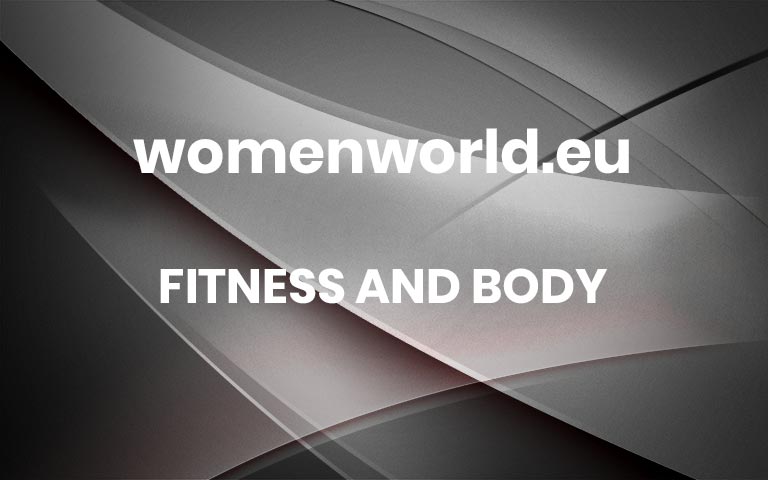‘Should I ditch the scale?‘ you’ve probably wondered to yourself while acting out your very own rendition of Naked & Afraid in your bathroom on a Monday morning. You’re stark naked, weighing in the hopes of seeing a lower number with your mood at the mercy of the digits below your feet. And it begs the question, can you achieve your goals without this seemingly torturous weekly act? Well, one woman is here to tell you that you can – because she did it herself.
Personal trainer Mirjam Breedt’s passion for exercise – particularly strength training – transformed her commitment to wellness by making fitness an enjoyable and integral part of her daily routine. Discover how she overhauled her life and body and how you can, too.
The Stats
Occupation: Personal Trainer And Musician
Age: 35
Weight before: 75kg
Weight after: 69kg
Height: 1.75cm
Secret weapon to your weight loss: Consistency is everything. I don’t watch the scale.
The Culprit
I’ve always had a passion for sports, growing up in Mozambique in an active, though not always super healthy, family. I played soccer, basketball and participated in swimming and athletics. We were constantly on the move, but our diet was unrestricted. However, my active lifestyle took a hit when I tore my ankle ligaments while studying music, dance and drama, resulting in three months in a moon boot. Naturally, I became quite unfit during that period.
READ MORE: What Is Rucking? How To Try The Cardio And Strength Workout, According To Experts
My Turning Point
In mid-January 2014, after my ankle injury left me feeling flabby and incredibly weak, I met my husband. He introduced me to CrossFit and weight training, which were entirely new to me despite my familiarity with HIIT, running and basic gym routines. I distinctly remember hanging from a pull-up bar, thinking there was no way I could pull myself up. It was a stark realisation: if my life depended on it, I wouldn’t last ten seconds. That definitive moment was when I decided things had to change.
I understood then that this transformation wasn’t just about my appearance or how I felt in the moment. It was about my future, my potential children, my overall health and everything that comes with a vibrant life. As the saying goes, “choose your hard,” and I made my choice.
Before this epiphany, I’d experienced many weight fluctuations, swinging between being very thin and overweight, but it was always an unhealthy path driven solely by aesthetics. This time, it was different. I wanted to be both strong and healthy, committing to a lifestyle I could maintain forever.
“I understood then that this transformation wasn’t just about my appearance or how I felt in the moment. It was about my future”
How I Transformed My Body: Training For Strength vs Aesthetics
My Approach to Lasting Fitness
I achieved my fitness goals by consistently setting them, entering races, overhauling my eating habits and showing up every single time. My journey began with a deep dive into nutrition, focusing on foods I truly love and understanding effective food combinations.
The Diet That Helped Me Reach My Goals
As an O blood type, I have a natural inclination towards meat, and I realised early on that I needed a sustainable approach, not a fleeting fad diet.
I carefully considered what I was willing to give up and what I wasn’t. Ultimately, I decided to cut out refined carbs and sugar, opting instead for a diet rich in healthy fats and proteins – a strategy I maintain to this day. This approach means I can eat until I’m satisfied, with very rare compromises on foods I know I shouldn’t have.
READ MORE: 15 CrossFit Workouts You Can Do At Home
My Strength Training Philosophy
After years of experimenting with various training types and routines (unless I’m training for a specific event), I’ve settled into a consistent six-day-a-week schedule, with sessions typically lasting around 50 minutes.
Mondays, Wednesdays and Fridays are dedicated to CrossFit and weight training. Tuesdays, Thursdays and Saturdays focus on cardio, which usually involves running, interval training or a high-intensity game of squash.
I also incorporate activities like volleyball, netball, kitesurfing or surfing into my week whenever possible.
The Weekly Workout Schedule For Body Transformation:
Monday: CrossFit and weight training
Tuesday: Cardio (running, interval training, squash)
Wednesday: CrossFit and weight training
Thursday: (running, interval training, squash)
Friday: CrossFit and weight training
Saturday: (running, interval training, squash)
READ MORE: This Full-Body Dumbbell Strength Workout Hits Every Muscle Group
The Power Of Consistency
Once my mind was set, I just pushed through. Yes, some days are incredibly challenging, but my choices were so precise that they stopped being choices; they simply became non-negotiable. I continued to make small gains and consistent progress, which ultimately led to great things. Even throughout my twin pregnancy, I continued to train. Of course, this was done with the right guidelines, but fitness had become so ingrained in me that I couldn’t imagine stopping.
Images supplied
My Journey To Peak Strength And Fitness
I’ve reached a point where I feel stronger and healthier than ever before. While I may not be the fastest or lightest, I’m at my absolute fittest and strongest, exactly where I want to be.
I can perform 10 muscle-ups in a row, clean and jerk 75kg, cycle 50km and effortlessly run 21km if needed. My goal is to be perpetually ready, whether someone asks me to do a triathlon tomorrow or compete in a weightlifting competition.
My Achievements Along The Way
I’ve actively participated in numerous events, including several triathlons, Impi Warriors trail runs and many 21km trail and road races. I’ve also tackled the XTERRA South Africa off-road triathlon (an epic experience) and an Adventure Racing marathon.
In Netball 10s, I’m currently second in South Africa in the Deadly Dozen and top 10 worldwide for the 2025 season. I’m also proud to have qualified for the CrossFit Quarterfinals.
“It all started with just one failed pull-up, which turned into one proper pull-up, then a few.”
Competing On The World Stage
Last year, my husband and I entered the IFBB (International Fitness and Bodybuilding Federation) championship as a mixed pair at the Western Cape tryouts in May. Unsure of what to expect, we competed and advanced to the South African championships. After winning Gold at the SAs in both team and individual categories, we earned our spot at the World Championships in Santa Susanna, Spain.
I often look back at the pull-ups as a pivotal moment for me. I completed 23 strict pull-ups in 2 minutes! Individually, I placed 4th in the open category and my husband and I secured 5th place in the pairs. With our two other South African teammates, we proudly earned third place in the large team event.
Standing on the podium at the World Championships was an absolutely amazing feeling – something I never imagined or even aimed for. It all started with just one failed pull-up, which turned into one proper pull-up, then a few, eventually leading us to the World Championships in November 2024.
Three Principles For A Successful Strength Transformation
1. Make The Right Decisions
Choose a fitness routine you genuinely enjoy and can stick with for the long haul. Consistency is key! However, remember that you can’t out-train poor food choices. Nutrition plays a massive role in your success.
2. Don’t Quit
As a mom of twins who breastfed for over a year, I know exhaustion. Some days you’ll only have 10% to give, and other days you’ll have 90%. That’s perfectly fine – just don’t stop. If it means walking instead of running, do it. Ten minutes of activity is always better than none.
3. The Scale Is Just A Guideline
While muscle weighs more than fat, your waistline will never lie. Pay more attention to how your clothes fit and how you feel. Also, be prepared for moments of weakness. Keep healthy, sweet and savoury snacks on hand, and when in doubt, choose protein.
Make A Batch Of These Snacks To Keep On Hand When Cravings Hit:
Dark Chocolate Power Bark
Photo by Mike Garten
Pistachio Energy Balls
Photo by Sam Kaplan
Flax Energy Bites
Photo by Nino Schinco More



